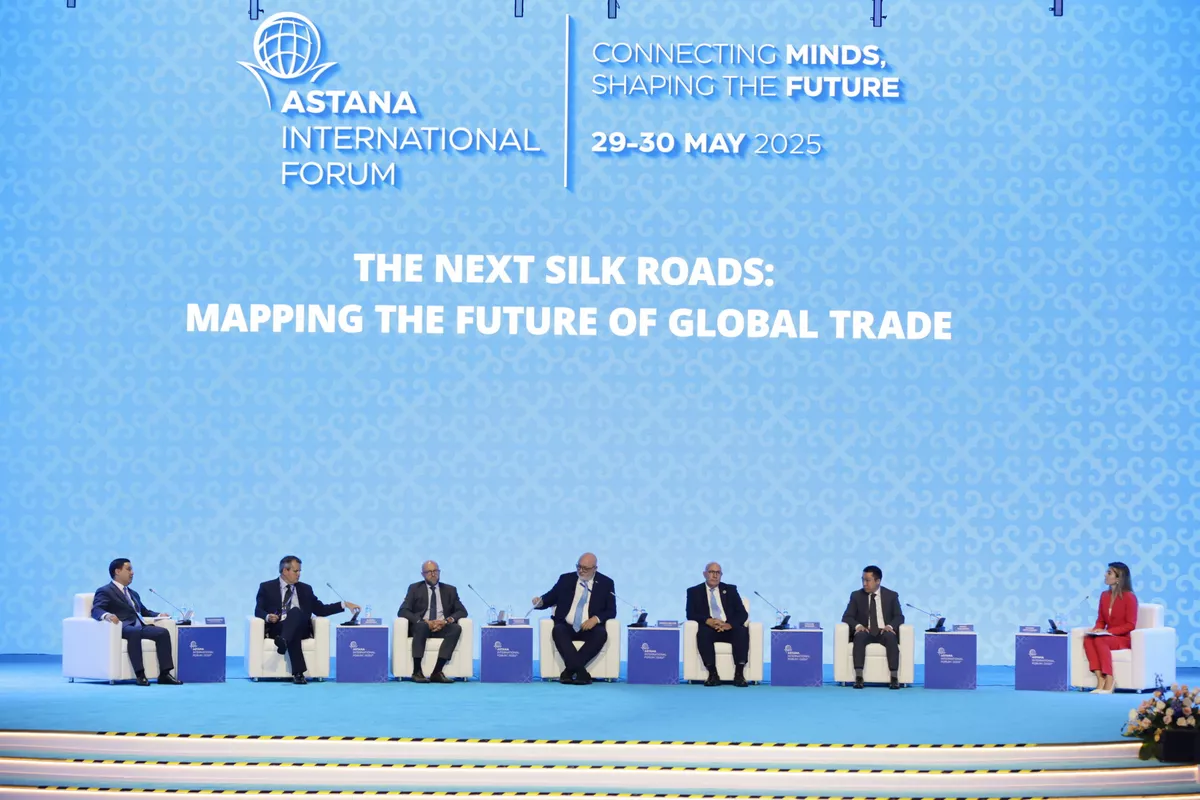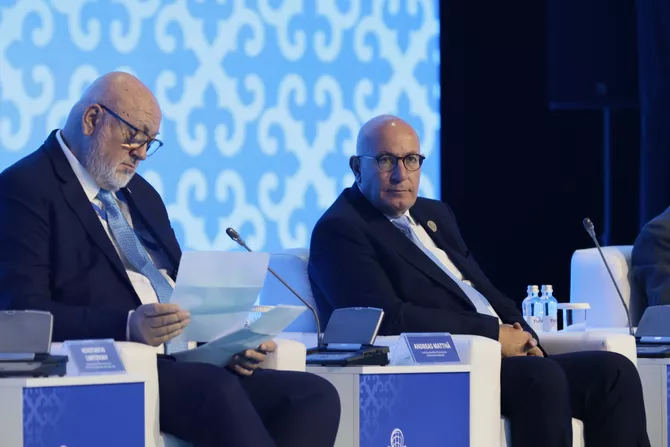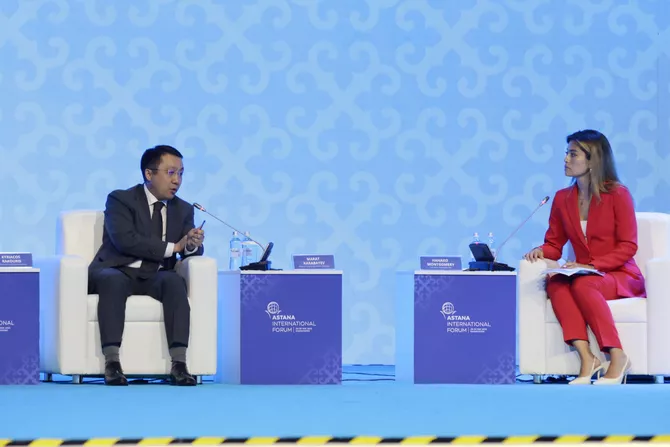
Photo credit: AIF press service
Experts at the “Next Silk Roads: Mapping the Future of Global Trade” panel during the second day of the Astana International Forum (AIF) 2025 emphasized that the development of the Middle Corridor will strengthen Kazakhstan’s position in global logistics and trade, while also boosting the region’s resilience to global supply chain disruptions, The Caspian Post reports citing The Astana Times.
Capitalizing on growth amid uncertainty
Uncertainty surrounding tariffs introduced by the US administration could, in fact, create new opportunities for the Central Asian region, experts suggest.

Andreas Matthä (L) and Kyriacos Kakouris (R). Photo credit: AIF press service
According to Andreas Matthä, CEO of Österreichische Bundesbahnen (Austrian Federal Railways), the tariff dynamics may help boost trade volumes along the Middle Corridor.
“Because the trade volume between China, Central Asia and Europe grew up, and grew up because the trade volume changes between China and USA. So it’s a big chance for the Middle Corridor and the countries along this corridor. It’s the opportunity to make peaceful trade between the countries and connection between China and Central Europe, and Central Asia and Europe,” said Matthä.
His view is echoed by Kyriacos Kakouris, vice-president of the European Investment Bank, who said that countries along the Middle Corridor have a unique opportunity to strengthen their position at the centre of new global supply chains.
“I think this uncertainty on international trade exactly justifies the decision of Kazakhstan and the other countries of the region to promote and go ahead with [Trans]-Caspian corridor or Middle Corridor, which is not just a route, it’s a strategic getaway, linking Central Asia and Europe, offering diversification, resilience and economic opportunity,” said Kakouris.
Asian Infrastructure Investment Bank’s (AIIB) Chief Investment Officer, Public Sector & Project and Corporate Finance Clients, Konstantin Limitovskiy, said that the Middle Corridor represents a revitalization of the ancient Silk Road, providing direct connectivity not only with China but with the broader East Asian region.
“I think that the country is revitalizing the ancient Silk Way, in order to really bring the diversification to the roots between East Asia through Central Asia, involving Central Asia, to the European part,” said Limitovskiy.
“This is the new old route, which is emerging because it is becoming more efficient. It is becoming a real alternative for the possible disruptions of other routes, and which would play with its important role growing more, maybe not that quickly reaching the level of Northern Corridor, but nevertheless becoming a security for that great cooperation between East Asia, not only China, East Asia and Southeast Asia and Europe,” he added.
The prospects and bottlenecks along the Middle Corridor
Kazakh Minister of Transport Marat Karabayev spoke about ongoing developments along the Middle Corridor and efforts to address infrastructure bottlenecks.
“If you look at 2021, this corridor used to be 800,000 [tons] and now, within the last three years, it ended up with 4.5 million, which is almost seven times increase for three years, which is good. And I totally believe that this corridor will hit by 2027 more than 10 million, at least, we have the all proving figures in order to make this kind of statement,” said the minister.
He also pointed to the fact that Kazakhstan’s economy grew by 6% in the first four months of 2025, and 25% of that growth is attributed to the transport sector.

Kazakh Minister of Transport Marat Karabayev (L). Photo credit: AIF press service
Addressing the challenges of managing a complex system and eliminating bottlenecks, the minister noted that railway operations along the route are managed by Middle Corridor Multimodal, a joint railway company established in 2023 by Kazakhstan, Azerbaijan, and Georgia.
“What is more important now, China is joining this single company. So this four main countries on this road are managing all the issues. As long as they have 25% share for their interest, as long as they have the same amount of the share, they are working on eliminating all the bottlenecks,” said Karabayev.
“With regard to Kazakhstan, we are investing on eliminating the bottlenecks of this corridor, roughly about four billion US dollars, only in the railway sector,” he added.
Sustainability of the Middle Corridor
Fostering integrated players along the supply chain and a strong focus on environmental sustainability is essential for creating more resilient trade routes today, according to Kakouris.
“Connectivity today is not just about hard infrastructure, not about road - it’s about creating resilient, efficient and sustainable trade routes that respond to the needs of the 21st century and the needs of the people of today. It is about ensuring that countries like Kazakhstan and its neighbors are not just points, but value-added hubs integrated into global supply chains. And it’s about building digital energy and transport corridors that work for people, the environment and economies alike,” he said.
Kakouris also emphasized the importance of building green and sustainable connectivity.
“The future growth must be sustainable, inclusive and forward-looking. That means electrified rail networks, digital customs systems, renewable energy integration and infrastructure that can withstand climate shocks,” said Kakouris.
“I am very pleased to hear the minister [Karabayev] saying that they are targeted to that direction. Kazakhstan’s commitment to achieving carbon neutrality by 2060 and its participation in the global methane pledge demonstrate its dedication to environmental sustainability. The EU is eager to support Kazakhstan in these endeavors, sharing expertise and providing instruments to facilitate the transition,” he added.
Limitovskiy said that broader integration between participating countries is vital for the corridor’s sustainability.
“When we talk about the Middle Corridor, a majority of us were talking about the transit capacity, the transit potential, but we, at AIIB, believe that unless you incorporate the intraregional trade, unless you would count on the development of the intraregional cooperation, you cannot really count on the real prosperous development of that route or system of those. Over the last three-five years, we can see that there’s a tremendous and very great development of the international and intraregional cooperation,” said Limitovskiy.
Share on social media